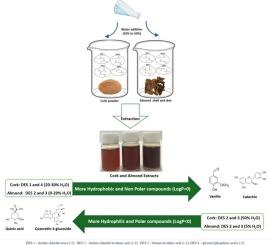Optimizing extraction from cork and almond wastes: the role of water in deep eutectic solvents
IF 5.2
2区 化学
Q2 CHEMISTRY, PHYSICAL
引用次数: 0
Abstract
Four deep eutectic mixtures (DES) with varying water concentrations (10 % to 50 %) were synthesized using naturally derived and biodegradable components: choline chloride:urea (ChCl:U), choline chloride:levulinic acid (ChCl:Lev), betaine:levulinic acid (Bet:Lev), and glycerol:phosphoric acid (Gly:Ph). These ternary mixtures, designed as greener alternatives to conventional solvents, were tested as substitutes of anhydrous DES to extract bioactives from agro-industrial residues, specifically cork and almond by-products and analyzed by HPLC-MS. As water content increased, conductivity rose while viscosity, density, and refractive index decreased. Water addition lowered melting temperature of DES, suggesting structural disruption or modification of molecular packing. FTIR-ATR and 1H NMR confirmed hydrogen bonding in the ternary system. High concentrations of phenolics, including protocatechuic acid and vanillin, were identified in cork extracts (DES 2 and 3 with 50 % water). In almond extracts, protocatechuic acid, catechin, and isorhamnetin-3-O-rutinoside were the primary compounds identified (DES 2 and 3 with 50 % water). DES-H2O mixtures demonstrated higher extraction yields, resulting in extracts with higher phenolic and flavonoid content and enhanced antioxidant activity compared to anhydrous DES.
These findings highlight the potential of DES-H2O mixtures as sustainable, green and high-efficiency solvents alternatives, offering an environmentally friendly approach aligned with circular economy and green extraction technologies.

软木和杏仁废料的优化提取:水在深共晶溶剂中的作用
采用天然衍生和可生物降解的组分:氯化胆碱:尿素(ChCl:U)、氯化胆碱:乙酰丙酸(ChCl:Lev)、甜菜碱:乙酰丙酸(Bet:Lev)和甘油:磷酸(Gly:Ph)合成了四种不同水浓度(10%至50%)的深共晶混合物(DES)。这些三元混合物被设计为传统溶剂的绿色替代品,作为无水DES的替代品,用于从农业工业残留物中提取生物活性物质,特别是软木和杏仁副产品,并通过HPLC-MS进行分析。随着含水量的增加,电导率升高,而粘度、密度和折射率降低。水的加入降低了DES的熔融温度,表明DES的结构被破坏或修饰。FTIR-ATR和1H NMR证实了三元体系中存在氢键。高浓度的酚类物质,包括原儿茶酸和香兰素,在软木提取物(DES 2和3与50%的水)中被鉴定。在杏仁提取物中,原儿茶酸、儿茶素和异鼠李素-3- o -芦丁苷是鉴定的主要化合物(DES 2和3在50%的水条件下)。与无水des相比,DES-H2O混合物的提取率更高,提取物的酚类和类黄酮含量更高,抗氧化活性也更强。这些发现突出了DES-H2O混合物作为可持续、绿色和高效溶剂的潜力,提供了一种符合循环经济和绿色提取技术的环保方法。
本文章由计算机程序翻译,如有差异,请以英文原文为准。
求助全文
约1分钟内获得全文
求助全文
来源期刊

Journal of Molecular Liquids
化学-物理:原子、分子和化学物理
CiteScore
10.30
自引率
16.70%
发文量
2597
审稿时长
78 days
期刊介绍:
The journal includes papers in the following areas:
– Simple organic liquids and mixtures
– Ionic liquids
– Surfactant solutions (including micelles and vesicles) and liquid interfaces
– Colloidal solutions and nanoparticles
– Thermotropic and lyotropic liquid crystals
– Ferrofluids
– Water, aqueous solutions and other hydrogen-bonded liquids
– Lubricants, polymer solutions and melts
– Molten metals and salts
– Phase transitions and critical phenomena in liquids and confined fluids
– Self assembly in complex liquids.– Biomolecules in solution
The emphasis is on the molecular (or microscopic) understanding of particular liquids or liquid systems, especially concerning structure, dynamics and intermolecular forces. The experimental techniques used may include:
– Conventional spectroscopy (mid-IR and far-IR, Raman, NMR, etc.)
– Non-linear optics and time resolved spectroscopy (psec, fsec, asec, ISRS, etc.)
– Light scattering (Rayleigh, Brillouin, PCS, etc.)
– Dielectric relaxation
– X-ray and neutron scattering and diffraction.
Experimental studies, computer simulations (MD or MC) and analytical theory will be considered for publication; papers just reporting experimental results that do not contribute to the understanding of the fundamentals of molecular and ionic liquids will not be accepted. Only papers of a non-routine nature and advancing the field will be considered for publication.
 求助内容:
求助内容: 应助结果提醒方式:
应助结果提醒方式:


